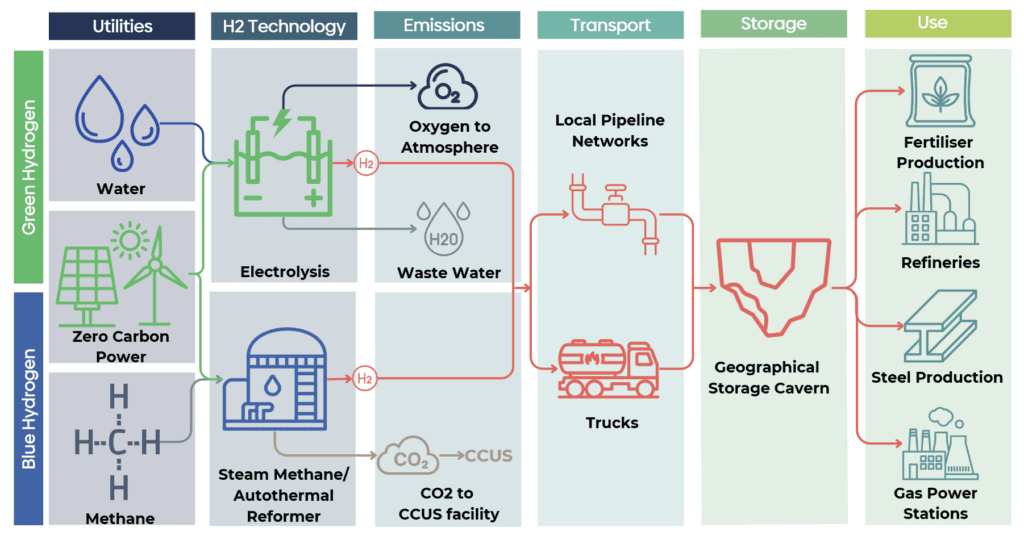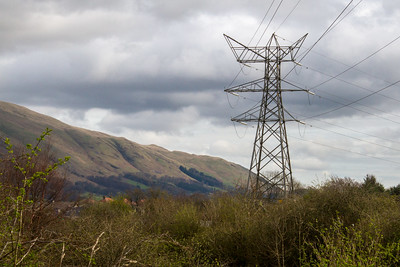I spent 9 months at Olsights and this is what I learnt…
My name is Sadeea and for the past 9 months, I have been an intern at Olsights as part of my Year in Industry placement for my Chemical Engineering degree. My role as a chemical engineering intern was predominantly to help expand the suite of energy project screening tools, research into new and exciting engineering related technologies and projects as well as general organisation of the engineering library data to ensure it is secure, remotely accessible, and easy to maintain and analyse.
I had the opportunity to work on many different and impactful projects. These projects showcased the innovative use of data visualisation tools such as Power BI and the integration of renewable energy technologies into practical applications.
Chemical Engineering Learning Opportunity
The first project I was involved in was a hydrogen research and visualisation project for The Crown Estate which involved conducting research on hydrogen supply and projected demand, and then visualising the findings using Power BI. I worked closely with the team to seek reliable and published sources of information to create a dataset on projected hydrogen supply and demand up to 2050. I was able to extract meaningful insights and create visually engaging dashboards which was then presented in-person to the team we worked closely with at The Crown Estate in their lovely office with a brilliant rooftop view as shown below.

The next project was a research project where I was responsible for curating a large dataset on renewable energy production and consumption from various academic resources. I worked closely with another intern who specialises in machine learning and data processing to ensure the accuracy and reliability of the data by also asking for feedback from Tony on the values and information gathered. I implemented data cleaning and pre-processing techniques to standardise the dataset for analysis and visualisation. The curated dataset will then be visualised using Olsights’ web map application, providing users with valuable insights into renewable energy trends and potential.
In another project, I focused on creating a solar PV (photovoltaic) application. I conducted extensive research on existing solar apps which I then implemented onto the website for users to easily find and use. Furthermore, I learnt about specific energy calculations, including factors such as irradiance, panel efficiency, and shading. Based on this research, I created a calculator using Excel to first input initial values and calculations and then built on this after by carrying out more research to make this as accurate as possible.
These calculations were then converted to an online calculator using Calconic that allowed users to estimate solar PV system performance and potential energy savings as shown below. The calculator was designed with a user-friendly interface and provided accurate values to facilitate decision-making for individuals and businesses considering solar energy adoption. This project highlighted the importance of translating complex engineering calculations into accessible and practical tools.
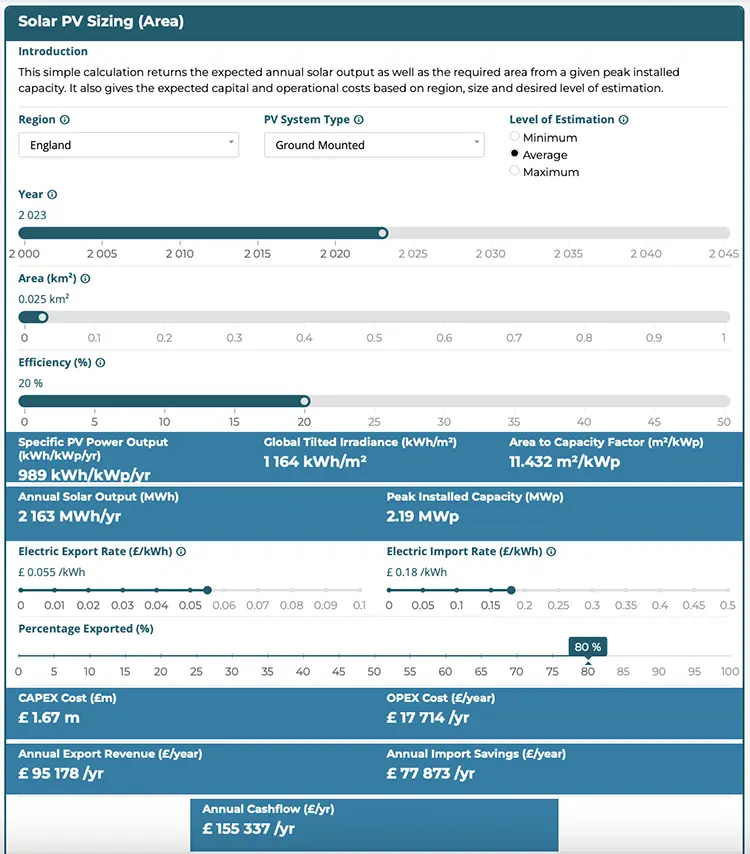
Lastly, the most recent project I took part in was the discovery phase of a SIF project with SSEN. This focused on researching planned renewable hydrogen projects in Scotland that will connect to the transmission grid. From the data obtained by Mapstand, I was able to analyse this using Excel and carry out calculations based on capacity such as electric power requirement, pure water and seawater requirement. I was then able to apply these calculations to all future hydrogen projects and visualise this data using Power BI as well as create an online Calconic calculator to allow users to easily and quickly lookup expected values for a project. As seen below, I used powerful visual tools to show the relation between capacity and voltage level as well as water requirement and pipe sizing. This and previous projects allowed me to become very skilled at using Power BI which is an essential tool used for data visualisation and so has really helped to strengthen my data analysis skills.
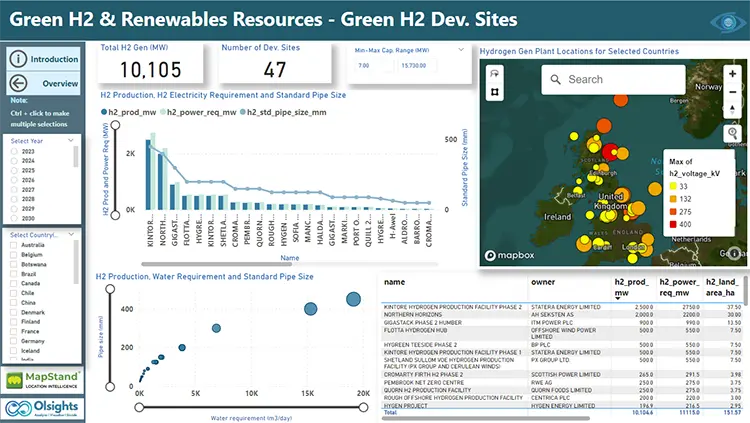
These projects have allowed me to apply my technical skills in data visualisation, research, and web development and have provided me with a deeper understanding of the energy transition and the role of innovative technologies in accelerating its progress. By collaborating with the team and engaging with clients’ requirements, I was able to contribute to the development of practical solutions that empowered users to make informed decisions regarding renewable energy adoption.
Learning Experience
This experience has solidified my passion for leveraging technology to address environmental and engineering challenges. I was able to achieve the personal targets I had set myself from the start of the internship and really build on my strengths including adaptability as I was working on varied projects which covered different areas of engineering. I was also able to use my knowledge to solve problems whether that be mathematically or technically. Working with different groups of people strengthened my communication skills and showed me the importance of collaboration as well as asking for help and feedback when needed. This was something that I found difficult to get used to as I was familiar with working independently on assignments in university, therefore I am very glad that I had the opportunity to work with different people and understand the significance of this. In addition, learning how to use powerful tools such as Power BI is such a useful skill to have and apply to projects in the future, the image below shows a really cool “beeswarm” visual of planned future UK wind farm projects sorted by capacity and project status.
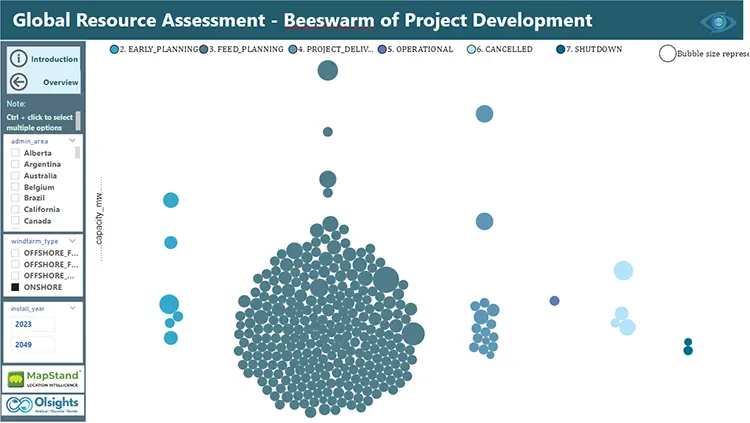
Furthermore, I learnt a lot about myself in the last 9 months. Although working in the corporate world was a daunting concept coming out of my third year of university, with the help and guidance of my team, this placement show me that I am ready for the world of work and making mistakes is a part of the process. I would definitely recommend for students to try to secure an internship during/after their degree as it exposed me to so many ideas and concepts that I would never have been exposed to and allowed me to learn and grow before getting a job I’d be fully committed to.
What’s next?
Building on my internship experience at Olsights, I plan to use the data and visualisation skills obtained and apply them to a design engineering role. I also aim to continue exploring opportunities in the renewable energy sector and leverage my technical expertise to contribute to a sustainable future.
With this amazing experience and new set of skills, I was able to secure a graduate engineering job at Max Fordham in September. In the future, I wish to train to hopefully become a chartered engineer in the renewable energy sector and try to make a difference in the world. So, I just want to say a huge thank you to Olsights and their team for being a part of my journey and for this incredible experience!



